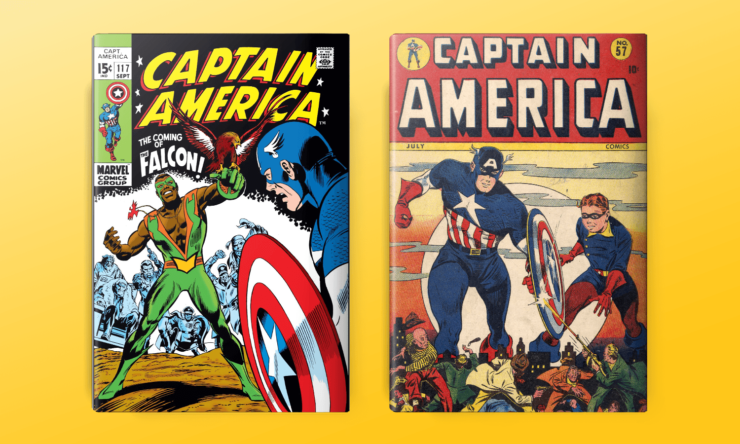Throughout his eighty-year history in the comics, Captain America has often worked alongside others, whether it’s with individual partners or his various teammates in the Invaders and the various Avengers teams.
However, the two partners who are best known, and have collectively spent the most time fighting by Cap’s side, are James Buchanan “Bucky” Barnes, a.k.a. the Winter Soldier, and Samuel Thomas “Sam” Wilson, a.k.a. the Falcon. They’re also two of the three non-Steve Rogers people who’ve been Captain America since Rogers was revived in modern times by the Avengers. They both owe a part of their backstories to the Cosmic Cube. And their Marvel Cinematic Universe counterparts are about to star in their own TV show starting this week.
As the 1960s drew to a close, Marvel had already supplanted DC as the top superhero comic publisher, but they wanted to do more to broaden their appeal. They had already introduced one superhero of color—Black Panther—in the pages of Fantastic Four, and in the pages of Captain America, they created another.
Sam Wilson first appeared in Captain America Vol. 1 #117 by Stan Lee & Gene Colan (1969) on a remote island owned by the Red Skull. The Skull had his hands on the all-powerful Cosmic Cube at the time, and had switched bodies with Cap, so it was Cap in the Skull’s body who wound up on the island fighting the Exiles, a group of super-powered Nazis with a grudge against the Skull.
Wilson was a man from Harlem with an affinity for birds—and one in particular, a falcon named Redwing with whom he had a mental link—who answered an ad to work for the Exiles and hopped a freighter to the island. But he soon realized that they were bad news. Cap trains Wilson in hand-to-hand combat, and the pair of them (and Redwing) take on the Exiles. They eventually defeat the Skull, as well, and they both return to New York safe and sound.
After a storyline in which Cap thinks Bucky has come back to life (it turns out to have been an android), he goes to Wilson in issue #133 by Lee & Colan (1971) and asks Falcon to be his partner. With the next issue, the comic’s name was changed to Captain America & The Falcon, symbolizing a partnership that would remain intact until Falcon was assigned by S.H.I.E.L.D. to head up a team of Super Agents in issue #218 by Roy Thomas, Donald F. Glut, & John Buscema (1978). (Falcon’s name stayed on the cover until issue #222, though.) Originally, he was just a well-trained fighter, but the Black Panther gave Sam a set of wings in issue #170 by Steve Englehart, Mike Friedrich, & Sal Buscema (1974), which he would keep thenceforth.
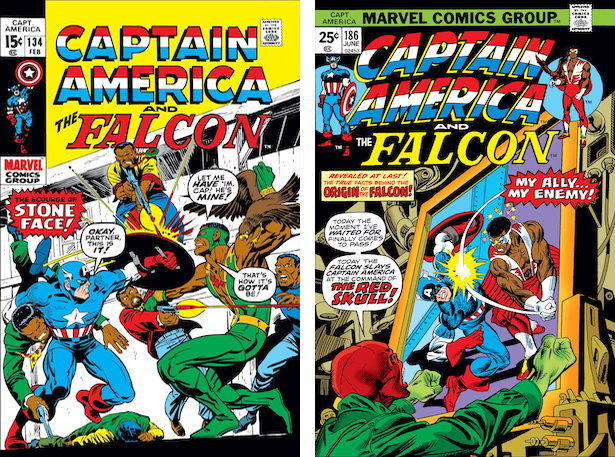
His origin got a bit more complicated in issue #186 by Englehart, John Warner, & Frank Robbins (1975). The Skull revealed that Wilson wasn’t just some random guy from Harlem who answered an ad and hopped a freighter. He was a gangster called “Snap” Wilson, who’d moved from Harlem to Los Angeles after his parents were killed and became a major drug dealer. It was while flying back from Rio de Janeiro to do business that he crashed on the island. Skull used the Cube to erase his memory and give him a new personality to make him the perfect partner for Cap, to act as a Trojan horse and later betray him. Wilson struggled with his dual identities, particularly when running for political office in a series of backup stories in issues #276-278 by J.M. DeMatteis & Mike Zeck (1983), but the entire “Snap” backstory was revealed as racist bullshit created by the Skull because he was a Nazi shithead in All-New Captain America #3 by Rick Remender & Stuart Immonen (2015).
(The original retcon in 1975 was to address some absurdities in the original story. The Exiles were, well, exiles on an uncharted island. They had no means to take out an ad, nor would any freighter have ever gone anywhere near there. However, the retcon had additional inconsistencies, plus it really was racist as hell, so the 2015 retcon to the retcon was quite welcome.)
Buy the Book
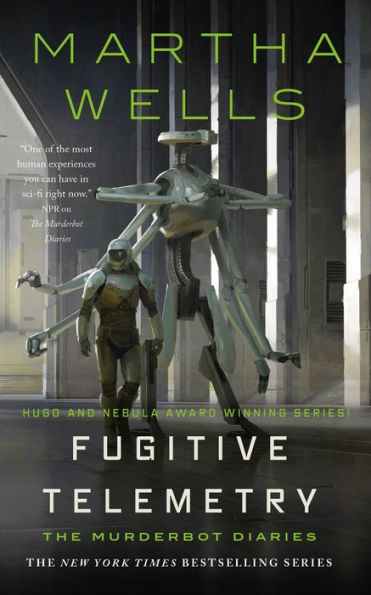

Fugitive Telemetry
Falcon first joined the Avengers in Avengers Vol. 1 #181 by David Michelinie & John Byrne (1979) when the U.S. government forced the team’s roster—which by then was pretty huge in the wake of the battle against Korvac—down to six. Affirmative Action dictates required that there be a minority in the group, so they insisted that Falcon be added. Hawkeye was cranky, seeing Falcon as essentially taking his spot on the team, and Falcon wasn’t all that thrilled with being the token black guy, either, and he quit the team thirteen issues later.
He eventually rejoined the Avengers during a battle against Scorpio, and he later exposed U.S. Secretary of Defense Dell Rusk as the Red Skull in the “Red Zone” storyline that culminated in Avengers Vol. 3 #70 by Geoff Johns & Oliver Coipel (2003). How it took everyone so long to figure out that Dell Rusk was the Red Skull is left as an exercise for the reader. (I figured it out about two pages after the character first appeared…)
There was a new Captain America & The Falcon series from 2004-2005 written by Christopher Priest, which led to a temporary rift in their friendship, and then Cap was assassinated by a brainwashed Sharon Carter in Captain America Vol. 5 #25 by Ed Brubaker & Steve Epting (2007), which was at the end of the lengthy “Civil War” storyline. Falcon was heavily involved in the aftermath of Cap’s death, which culminated in Bucky taking over as Cap. (More on that below.)
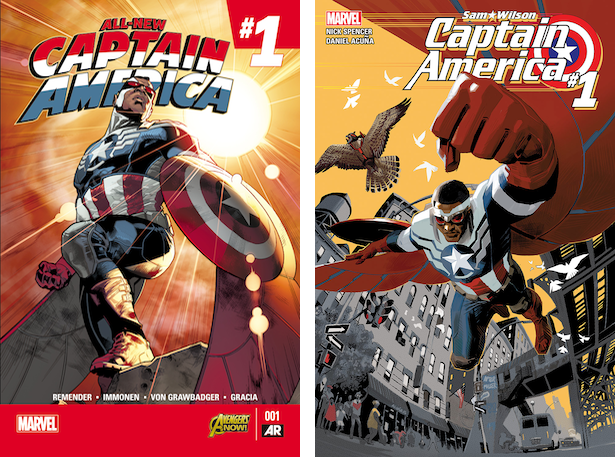
Cap came back from the dead (of course) and took the mantle back, but then by Captain America Vol. 7 #25 by Remender, Immonen, & Carlos Pacheco (2014), Cap had been aged in Dimension Z by Arnim Zola. Unable to continue out in the field, the elderly Cap handed the shield and uniform over to Wilson in that issue. Wilson starred as Cap in All-New Captain America by Remender et al (2015) and then in Captain America: Sam Wilson by Nick Spencer et al (2015-2017). Rogers was de-aged and became Cap again in Captain America: Steve Rogers #1 by Spencer & Jesus Saiz (2016).
Upon learning that Cap was a long-term Hydra mole, Wilson returned to the Falcon identity in issue #24 of Captain America: Sam Wilson by Spencer, Donny Cates, & Joe Bennett (2017), the last issue of that title. (Cap being Hydra was revealed later to be false memories implanted in Rogers.) Falcon now has a sidekick, the Patriot, and their adventures were seen in the Falcon series that ran from 2017-2018 by Rodney Barnes & Joshua Cassara, which was Falc’s first solo title as the Falcon since an excellent four-issue miniseries in 1983 by Jim Owsley, Paul Smith, & Mark Bright.
***
Bucky was introduced alongside Captain America as his teen sidekick in Captain America Comics #1 by Joe Simon & Jack Kirby (1941). While the U.S. hadn’t yet entered World War II, the two creators, who were born Hymie Simon and Jacob Kurtzberg, were greatly concerned about Nazi aggression in Europe, and created Captain America as a symbol of American freedom and strength, created specifically to fight Nazis. (The cover of his first issue has Cap punching Hitler.)
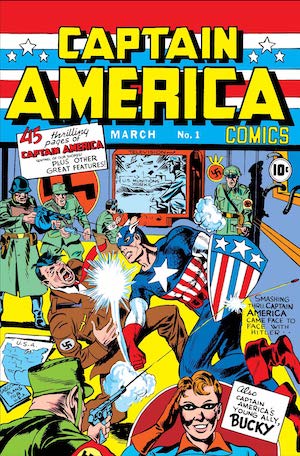
Teen sidekicks were all the rage in the first half of the 20th century, so Bucky was a natural partner for Cap at the time. Sixteen-year-old Bucky Barnes was the unit mascot at Camp Lehigh, who discovered Corporal Steve Rogers changing clothes into Captain America, and then became his sidekick. (This was retconned to a less child-endanger-y origin in Captain America Vol. 1 #620 by Brubaker, Marc Andreyko, & Chris Samnee [2011], wherein Bucky was actually trained as a teenager—in part due to nepotism, as his father was a respected officer—and assigned to be Cap’s sidekick.)
Bucky fought alongside Cap throughout World War II and beyond, into the 1950s, before Cap’s comics (like most superhero comics after the war ended) petered out. Cap was eventually revived in Avengers Vol. 1 #4 by Lee & Kirby (1964), which established that Bucky died in the waning days of the war, killed by Baron Zemo. Zemo sent a drone plane loaded with explosives out to destroy England. Cap and Bucky tried to stop it, and the force of the explosion killed Bucky and sent Cap into the ocean, where he was frozen for years until he was found by the Avengers, who were chasing Namor the Sub-Mariner.
There were numerous fake Bucky sightings over the years. There was the android fake that led to Cap asking Falcon to be his partner. And then there was the 1950s version.
The discontinuity between Avengers Vol. 1 #4 and the 1950s versions of the characters was resolved in Captain America Vol. 1 #153 by Englehart & Sal Buscema (1972). The 1950s Cap was retconned as a college professor who worshipped Cap, had plastic surgery to make himself look like him, and took on a student as his new Bucky. They even injected themselves with a version of the Super Soldier Serum, but it did something to their minds, making them insane. They were put in suspended animation, freed in issue #153, and later defeated by the real Cap. The 1950s Cap would kill himself rather than become a puppet of Dr. Faustus in issue #236 by Roger McKenzie, Michael Fleisher, & Sal Buscema (1979), but in issue #281 by DeMatteis & Zeck (1983), we learn that that Bucky survived. His real name is Jack Monroe, and he eventually was cured and became the costumed hero Nomad. He would be Cap’s partner, and then later venture on his own.
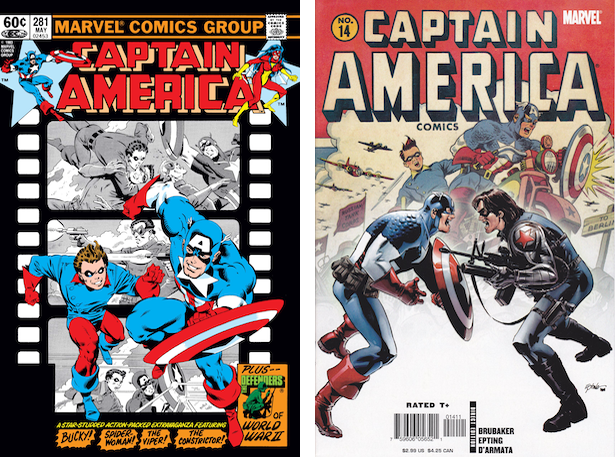
Nomad was a small but integral part of the consecutive storylines in Captain America Vol. 1 #153 Vol. 5 that introduced the Winter Soldier: “Out of Time” and “The Winter Soldier” by Brubaker, Epting, & Michael Lark (2004-2006). Those storylines revealed that Bucky, like Cap, fell into the ocean and was put in suspended animation by the frozen water, but brain dead and missing an arm. But while Cap floated around the Arctic, Bucky was found by a Soviet submarine and brought to Department X, which trained him, brainwashed him, and eventually gave him a cybernetic arm, turning him into a KGB assassin who could pass for American. His mental instability meant he had to be put into suspended animation between assignments, and he was mothballed before too long. He’d eventually become a myth in the intelligence community. Nomad was used as a scapegoat; since his fingerprints were modified to be the same as Bucky’s, he could be framed for the Winter Soldier’s actions. So Bucky killed him and left his corpse by a bomb he set off in Philadelphia.
When Cap learned of the Winter Soldier, he was able to use the Cosmic Cube to give him his memories back. After Cap was killed in the aforementioned Captain America Vol. 5 #25, Bucky went after the Red Skull, who was responsible for brainwashing Carter into shooting Cap. Then he learned that Cap wanted him to take over as the star-spangled Avenger if anything should happen to him, and Bucky agrees to do so in issue #33 by Brubaker & Epting (2007). He stayed as Captain America until Rogers came back from the dead in the Captain America: Reborn miniseries by Brubaker & Bryan Hitch (2009-2010). He goes back to being Bucky, though he does keep the shield with Rogers’ blessing.
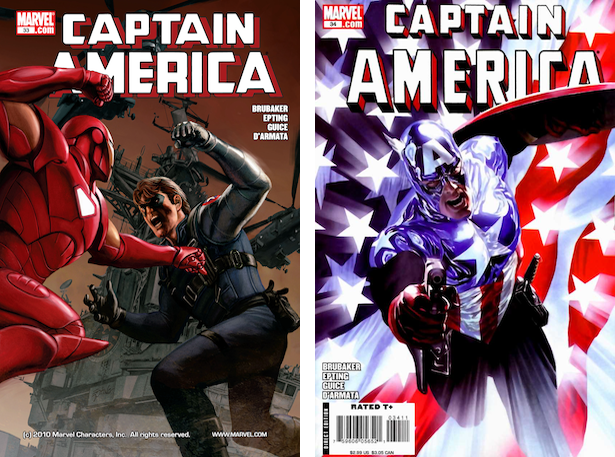
Bucky appears to die in the Fear Itself miniseries by Brubaker & Butch Guice (2011), but it was a ruse. They bury a Life Model Decoy in his grave and he goes back to being the Winter Soldier, starting in his first ongoing series, also by Brubaker & Guice, in 2012. He’s continued in the role since, having been granted a pardon after helping take down the most recent iteration of Hydra.
And of course, in anticipation of this week’s TV show, Marvel put out a Falcon & The Winter Soldier comic book last year by Derek Landy & Federico Vicentini.
***
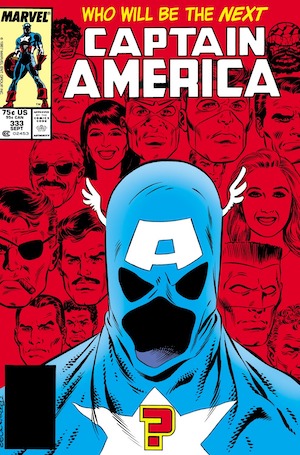
Just by the way, the third post-revival person to take over as Cap is John Walker, who first appeared as the Super-Patriot in Captain America Vol. 1 #323 by Mark Grueunwald & Paul Neary (1986), and who took over as Cap ten issues later in issue #333 by Gruenwald & Tom Morgan (1987), after Rogers was, in essence, fired from the job by the government. This replacement—which readers were told was permanent—lasted all of seventeen issues, as Rogers was back in the red-white-and-blue in issue #350 by Gruenwald & Kieron Dwyer (1989). Walker then took on the identity of the U.S. Agent. A version of Walker will be appearing in the Falcon & The Winter Soldier MCU series as well. (That Cap also had a sidekick named Bucky, who was African-American. His name was changed to Battlestar when Dwayne McDuffie gently informed the white Gruenwald that “buck” was a racial slur and that it was more than a little tone-deaf to call a black character “Bucky.”)
***
While the front stories of the Falcon and the Winter Soldier in the MCU track pretty well with the comics, the backstories have been significantly changed. Sam Wilson is a social worker in the comics, not an ex-soldier, and his wings came from Wakanda rather than the U.S. Army. And the Bucky Barnes of the comics didn’t meet Steve Rogers until after he became Captain America. His MCU role as his childhood friend basically tacked the role of Arnold Roth, introduced in Captain America Vol. 1 #286 by DeMatteis & Zeck (1982) as the guy who defended scrawny Steve Rogers from bullies, onto Bucky.
Still, these are two characters who have long histories as partners to the star-spangled Avenger, and who have at different times carried on his legacy in the comics as well. It’ll be fun to see the MCU version of this…
Falcon & The Winter Soldier debuts on Disney+ on Friday March 19th, 2021. Look for my reviews on the day of release…
Keith R.A. DeCandido has been writing for Tor.com since 2011, primarily babbling about TV & movie adaptations of superhero comics and Star Trek. His takes on the MCU films can be found as part of “4-Color to 35-Millimeter: The Great Superhero Movie Rewatch,” which launched in 2017 and which covers every live-action movie based on a superhero comic. He wrote two pieces on WandaVision, about how they used the characters’ comic history and how the show provided room for consequences and secondary character development.










